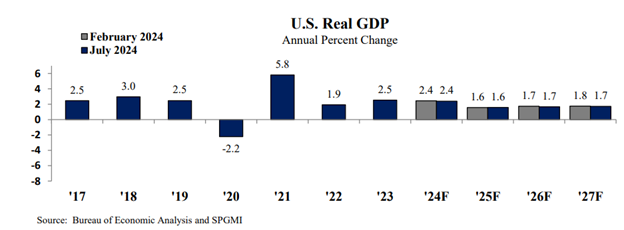Minnesota recently ended the fiscal year with revenues a bit above prior projections. Looking ahead, the national economic picture remains consistent with previous forecasts, according to the July Revenue and Economic Update from Minnesota Management and Budget.
Some of the top takeaways from the update include:
1. There is little change to the national economic projections compared to the February Forecast. Forecasters predict national GDP growth in 2024 to be 2.4 percent, 1.6 percent in 2025, and 1.7 percent in years 2026 and 2027. The Update notes that its economic growth projections are slightly more optimistic than the Blue Chip Consensus, another highly regarded economic projection. Inflation, as measured by the Consumer Price Index, is projected to be 3.0 percent in 2024 and 2.1 percent in 2025; these are slightly higher than inflation projections for these years released in February.

2. State revenues for the 2024 fiscal year came in higher than expected in the February forecast. The state’s 2024 fiscal year ended on June 30, and preliminary figures show general fund revenues for the fiscal year of $30.2 billion, which is $421 million, or 1.4 percent, higher than forecast in February. One major source of the increase was higher returns on investment income.
3. The official U.S. unemployment rate has increased. In June, the national unemployment rate was 4.1 percent, a result of 6.8 million people being unemployed, while at the same time nonfarm employment increased by 206,000 jobs. Forecasters predict that U.S. unemployment will average 4.0 percent in 2024, 4.4 percent in 2025, and 4.7 percent in 2026.
Connecting the dots between these figures and the state’s budget
The July economic update did not present any cues that would indicate major changes in the state’s budget figures compared to how they landed at the end of the legislative session in May.
The state’s February Forecast projected a $3.7 billion general fund surplus for the two-year budget cycle we are currently in (FY 2024-25), and a $2.2 billion projected positive balance at the end of the next biennium (FY 2026-27). In March, legislative leaders and Governor Tim Walz agreed to “budget targets” that described the size of changes they intended to make to the state budget passed last year. The targets outlined $478 million in net general fund changes in FY 2024-25 and $63 million in FY 2026-27. These changes could come from a combination of increased spending or reductions in revenues.
The tax and budget decisions enacted in the 2024 session did not deviate much from the targets agreement. Legislation passed in 2024 made a total of $424 million in changes to the FY 2024-25 budget and $94 million in FY 2026-27. At the end of session, the state budget balance was projected to be $1.7 billion by the end of FY 2026-27.
What’s next
We’ll get updated state revenue and national economic figures with the October Economic Update, and a fuller picture that takes both spending and revenues into account when the November budget forecast comes out late in the year. That will give a better sense of the budget context that policymakers will be working in when they set the state’s next two-year budget in the 2025 Legislative Session.